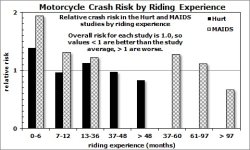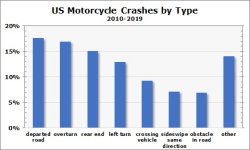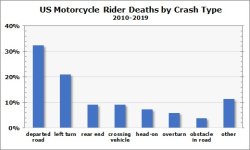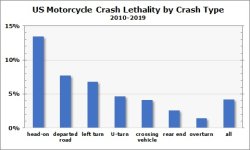DataDan
Mama says he's bona fide
Why have motorcycle crashes become deadlier?
The surprising conclusion from yesterday's post is that motorcycle crashes in the US and in California are more likely to be fatal now than they were 30 years ago. The percentage is low--only 4% of US crashes and 3% of California crashes take the life of the rider--but still, this seems contrary to what we know about the sport. Protective gear, improved and worn much more often than 30 years ago, should be reducing crash lethality.

However, since 1997 all-rider helmet laws have been repealed in six states, including four of the top 10 US motorcycle states. Has reduced helmet use increased crash lethality?

Seems not. In spite of the repeals, helmet use has been gradually rising, not falling. Even in states with no helmet requirement, helmet use has increased. In Michigan, the most recent repeal, 70% of crash-involved riders are wearing one. In Texas it's 59%, in Florida 55%.
Older riders are more vulnerable riders
After discovering the lethality increase a few years ago, I wondered if it had resulted from more violent crashes. Maybe brave young riders on 180mph sportbikes had inflated the fatality data. That guess was crushed when I found that young riders, particularly those under age 25, were at less risk of dying in the event of a crash than older riders. Digging deeper, I found that the 55+ age group, not the < 25 group, was pushing lethality higher.

And the 55+ age group has been growing for 30 years:

Since 1990, 26% of motorcyclists involved in crashes in the US have moved statistically from the least vulnerable age group--the under 25s--into more vulnerable groups, most of them into the most vulnerable groups. This accounts for a substantial part of the lethality increase.
In post #9 of this thread, I concluded that growth in the 55+ age group had reduced the crash rate. Increased crash lethality is the downside of that change.
Lethality by age in California is similar to the US:

My detailed California crash data includes rider age back only to 2001, so I can't present an age distribution graph that includes earlier years, but what I have does show that the percentage of crash-involved riders age 55+ doubled from 2001 to 2018:

A more deadly mix of vehicles on the road
Over the past 30 years, the typical family transportation appliance has morphed from a Taurus or Accord into an F-150, Odyssey, or Suburban. This has not been a welcome development for motorcyclists, because the latter group--classified as light trucks by NHTSA--is much less crash-friendly to us. The late Wendy Moon wrote about the impact of this shift in a 2004 Motorcycle Consumer News article, "Fatal Design", and I have kept track of the relevant crash data subsequently.

In 1990, light trucks--pickups, vans, minivans, SUVs, crossovers--comprised less than 20% of vehicles involved in 2-vehicle motorcycle crashes, but accounted for 32% of the rider deaths that occurred in those crashes. In that same year, cars accounted for 75% of crashes and 55% of deaths. Since then, light truck involvement has increased to 37% of crashes and 45% of deaths. Clearly, the difference in motorcyclist crash lethality between cars and light trucks is huge:

Conclusion
In spite of improvements in motorcycle protective gear and its growing use, crashing has become more deadly over the past 30 years. The observed increase in motorcycle crash lethality can be explained in substantial part by the aging riding population and the mix of other vehicles on the road. Neither of those factors is likely to change in the foreseeable future.
Motorcyclist median age seems to have stabilized in the late 40s. It has gone from a young man's sport to one that appeals to men and women over a wide age range. While crash risk is lower thanks to the presence of older, more conservative riders, vulnerability to fatal injury has increased due to the same change in age distribution.
For a variety of reasons, Americans enjoy big vehicles to transport themselves and their families. Fifty years ago it was a Buick Electra Deuce-and-a-Quarter. Today, it's a Ford F-350 or Mercedes GLS or whatever, which poses serious danger to a motorcyclist in the event of a crash. The increase in light trucks from < 20% of multiple-vehicle motorcycle crashes 30 years ago to 37% today has resulted in an additional 280 rider deaths per year by my estimate. In no feasible scenario will these vehicles soon become either less popular or less deadly.
The surprising conclusion from yesterday's post is that motorcycle crashes in the US and in California are more likely to be fatal now than they were 30 years ago. The percentage is low--only 4% of US crashes and 3% of California crashes take the life of the rider--but still, this seems contrary to what we know about the sport. Protective gear, improved and worn much more often than 30 years ago, should be reducing crash lethality.
However, since 1997 all-rider helmet laws have been repealed in six states, including four of the top 10 US motorcycle states. Has reduced helmet use increased crash lethality?
Seems not. In spite of the repeals, helmet use has been gradually rising, not falling. Even in states with no helmet requirement, helmet use has increased. In Michigan, the most recent repeal, 70% of crash-involved riders are wearing one. In Texas it's 59%, in Florida 55%.
Older riders are more vulnerable riders
After discovering the lethality increase a few years ago, I wondered if it had resulted from more violent crashes. Maybe brave young riders on 180mph sportbikes had inflated the fatality data. That guess was crushed when I found that young riders, particularly those under age 25, were at less risk of dying in the event of a crash than older riders. Digging deeper, I found that the 55+ age group, not the < 25 group, was pushing lethality higher.
And the 55+ age group has been growing for 30 years:
Since 1990, 26% of motorcyclists involved in crashes in the US have moved statistically from the least vulnerable age group--the under 25s--into more vulnerable groups, most of them into the most vulnerable groups. This accounts for a substantial part of the lethality increase.
In post #9 of this thread, I concluded that growth in the 55+ age group had reduced the crash rate. Increased crash lethality is the downside of that change.
Lethality by age in California is similar to the US:
My detailed California crash data includes rider age back only to 2001, so I can't present an age distribution graph that includes earlier years, but what I have does show that the percentage of crash-involved riders age 55+ doubled from 2001 to 2018:
A more deadly mix of vehicles on the road
Over the past 30 years, the typical family transportation appliance has morphed from a Taurus or Accord into an F-150, Odyssey, or Suburban. This has not been a welcome development for motorcyclists, because the latter group--classified as light trucks by NHTSA--is much less crash-friendly to us. The late Wendy Moon wrote about the impact of this shift in a 2004 Motorcycle Consumer News article, "Fatal Design", and I have kept track of the relevant crash data subsequently.
In 1990, light trucks--pickups, vans, minivans, SUVs, crossovers--comprised less than 20% of vehicles involved in 2-vehicle motorcycle crashes, but accounted for 32% of the rider deaths that occurred in those crashes. In that same year, cars accounted for 75% of crashes and 55% of deaths. Since then, light truck involvement has increased to 37% of crashes and 45% of deaths. Clearly, the difference in motorcyclist crash lethality between cars and light trucks is huge:
Conclusion
In spite of improvements in motorcycle protective gear and its growing use, crashing has become more deadly over the past 30 years. The observed increase in motorcycle crash lethality can be explained in substantial part by the aging riding population and the mix of other vehicles on the road. Neither of those factors is likely to change in the foreseeable future.
Motorcyclist median age seems to have stabilized in the late 40s. It has gone from a young man's sport to one that appeals to men and women over a wide age range. While crash risk is lower thanks to the presence of older, more conservative riders, vulnerability to fatal injury has increased due to the same change in age distribution.
For a variety of reasons, Americans enjoy big vehicles to transport themselves and their families. Fifty years ago it was a Buick Electra Deuce-and-a-Quarter. Today, it's a Ford F-350 or Mercedes GLS or whatever, which poses serious danger to a motorcyclist in the event of a crash. The increase in light trucks from < 20% of multiple-vehicle motorcycle crashes 30 years ago to 37% today has resulted in an additional 280 rider deaths per year by my estimate. In no feasible scenario will these vehicles soon become either less popular or less deadly.
Attachments
-
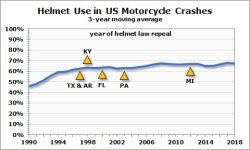 lethality helmet use.jpg44.6 KB · Views: 760
lethality helmet use.jpg44.6 KB · Views: 760 -
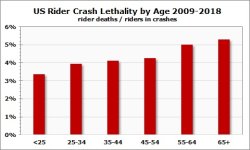 lethality age.jpg36.8 KB · Views: 295
lethality age.jpg36.8 KB · Views: 295 -
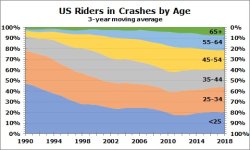 lethality age dist.jpg50.5 KB · Views: 297
lethality age dist.jpg50.5 KB · Views: 297 -
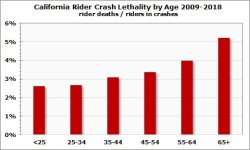 lethality by age CA.jpg34.8 KB · Views: 299
lethality by age CA.jpg34.8 KB · Views: 299 -
 lethality overall.jpg41.9 KB · Views: 282
lethality overall.jpg41.9 KB · Views: 282 -
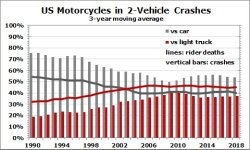 lethality lt involvement.jpg67.2 KB · Views: 292
lethality lt involvement.jpg67.2 KB · Views: 292 -
 lethality comparison.jpg36.4 KB · Views: 293
lethality comparison.jpg36.4 KB · Views: 293 -
 lethality age dist CA.jpg49.8 KB · Views: 288
lethality age dist CA.jpg49.8 KB · Views: 288
Last edited:

